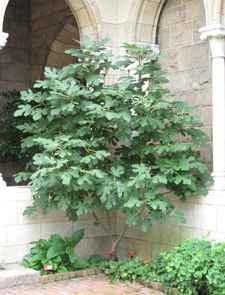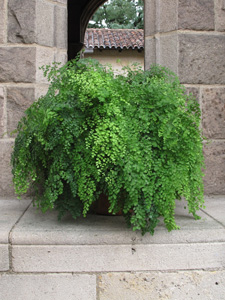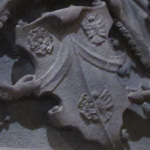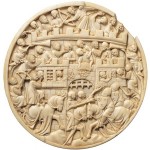Friday, September 23, 2011


A young fig tree flourishing in a sheltered corner of Bonnefont garden; detail of the ripe fruit (click to see full image)—note the tiny hole in the base of the fig at the lower right, and the milky sap that exudes from the stems when the figs are picked. This latex was a medicament and a rennet; it was also used as a mordant in medieval gilding and as a binder in the preparation of egg tempera. Photographs by Deirdre Larkin
So when the woman saw that the tree was good for food, and that it was a delight to the eyes, and that the tree was to be desired to make one wise, she took of its fruit and ate; and she also gave some to her husband, and he ate.
Then the eyes of both were opened, and they knew that they were naked; and they sewed fig leaves together and made themselves aprons.
—Genesis 3:6, 7
Much of the plant lore of the Middle Ages, like many other aspects of medieval culture, was a synthesis of classical and biblical tradition. The Tree of Knowledge is not named in the biblical account of the Fall; more than one species has been identified with the forbidden fruit, and the fig is among them. In Greco-Roman culture, the fig was associated with fertility and with the female genitalia. D. H. Lawrence explores this complex of cultural associations in his remarkable poem “Figs” (listen to a reading of this poem on YouTube).
Read more »
Tags: Adam, Alcinous, Athenaeus, Bugiardini, De Materia Medica, Deipnosophists, Dioscorides, Eisen, Eve, ficus carica, fig, forbidden, Genesis, Hildegard of Bingen, Pliny, Rumina
Posted in Food and Beverage Plants, Medicinal Plants | Comments (1)
Thursday, September 8, 2011


The lovely Venus maidenhair is not quite hardy for us at The Cloisters, and is grown in pots in the medieval gardens. The pinnules of this graceful fern, which flourishes in moist and rocky situations in many parts of the world, repel water. Photographs by Carly Still
The southern or Venus maidenhair (Adiantum capillis-veneris) belongs to a large genus of ferns that includes two hundred species. The botanical name given to the genus Adiantum is from the Greek for “unwetted,” since any water falling on the foliage of these ferns beads up, leaving the leaf surfaces dry. This species was already known by that name in classical antiquity; the Roman natural historian Pliny marveled that a plant that grew in moist places exhibited such a marked antipathy to water. According to Pliny, the plant was known to some as “beautiful hair” or “thick hair.” A decoction of the fern, made by simmering it with celery seed in wine and oil, was used both to dye the hair and to prevent it from falling out (Historia naturalis, Book XXII, 62–65). Read more »
Tags: Adiantum, baldness, Dioscorides, fern, Hortus Sanitatis, maidenhair, Maude Grieve, pinnule, Pliny, Rufinus, Salerno, stipe, Venus
Posted in Gardening at The Cloisters, Medicinal Plants | Comments (5)
Friday, September 2, 2011
Plantagenet. Since you are tongue-tied and so loath to speak,
In dumb significants proclaim your thoughts:
Let him that is a true-born gentleman
And stands upon the honour of his birth,
If he suppose that I have pleaded truth,
From off this brier pluck a white rose with me.
Somerset. Let him that is no coward nor no flatterer,
But dare maintain the party of the truth,
Pluck a red rose from off this thorn with me.
—Henry VI, Part 1, Act 2, Scene 4
After the fleur-de-lis, the rose is probably the second most common floral charge to appear on heraldic shields. That’s quite understandable, since the rose’s emblematic associations ranged from the Virgin Mary to the Five Wounds of Christ to romantic love. In the military context of knights and noble families, the rose also suggested the fierce and often impenetrable thicket of prickled branches in which it grows. The white roses strewn around the fearsomely armed lion rampant that occurs on the shield of Finland might have raised just such an association in the minds of beholders. Alternately, roses might also have been chosen as a play on a name—the arms of the German town of Rosenberg in Baden-Württemberg, for example, or the Baltic baronial family von Rosen.
Read more »
Tags: fleur-de-lis, heraldry, roses, Shakespeare, Tudor
Posted in Plants in Medieval Art | Comments (1)







